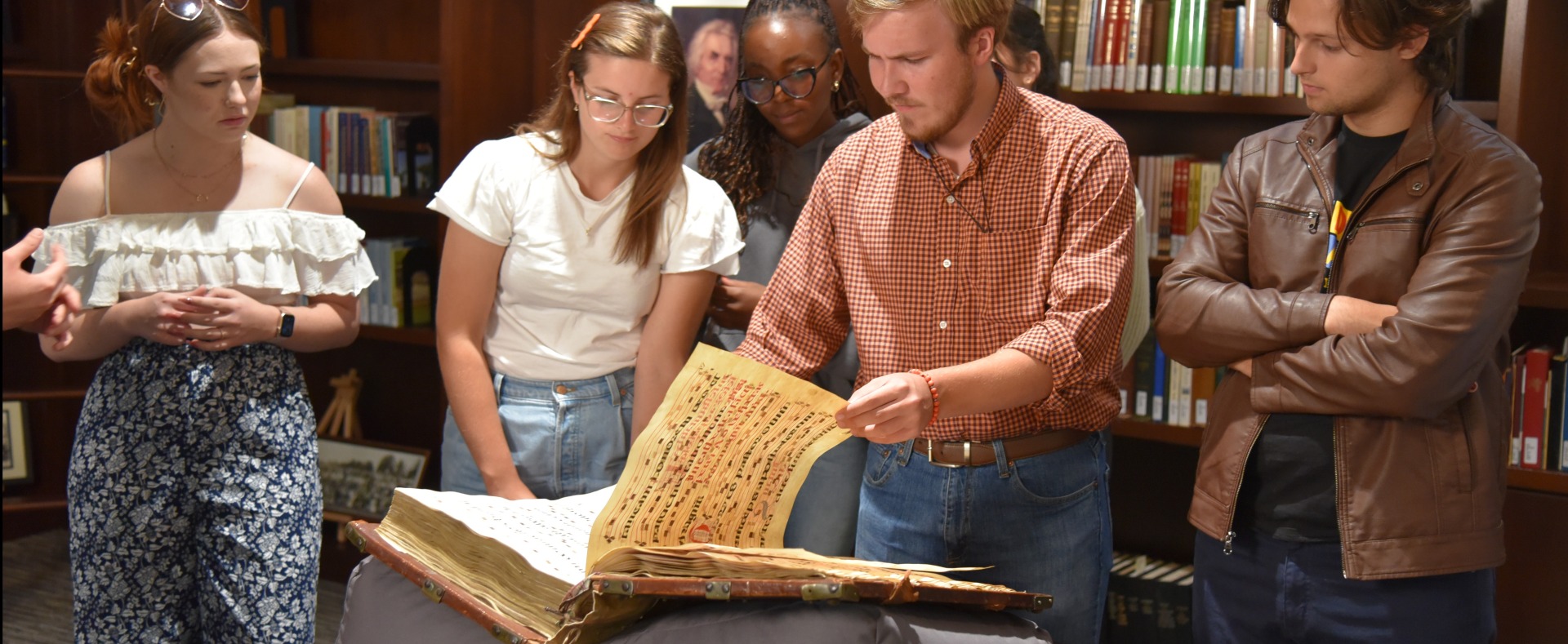
Pepperdine Libraries Seville Antiphonal
An antiphonal is a choir book with lyrics and melodies for chants performed during Catholic offices, or prayer services held throughout the day. Antiphonals typically include antiphons, or chants performed before the recitation of a psalm, and the psalms themselves. The size and structure of the choir book is designed to allow choirs to easily read the music as well as flip between antiphons and their corresponding psalms. The particular psalm performed on a given day is typically dictated by the church’s calendar of feast and holy days. That is why the index that has been added at the beginning of Pepperdine’s Seville antiphonal reads as a list of saint names or feast days.
This antiphonal was originally created in the late 16th Century for Catalina de Ribera, a Franciscan Abbess and Andalusian noblewoman in Seville, Spain. There are several references to the book’s Franciscan origins including the seal of Franciscan order depicting two arms over the cross, which appears on the cover of the antiphonal.
The book was rebound, collated, and given its current covers in 1798 by Franciscan Father Antonio de Cordova, as detailed in a note at the end of the index. The note also mentions that Father de Cordova was Preacher and former Vicar of the Choir in the Convent of the Casa Grande de N.S.P.S. Francisco de Sevilla. It notes that several chants were added at the time of rebinding and that the undertaking was paid for by the Vicar of the Choir, the Mother Superior Maria Dolores Cordero.
Click on the link below to view the antiphonal and to browse the various chants included
Pepperdine Libraries Seville Antiphonal
An antiphonal is a choir book with lyrics and melodies for chants performed during Catholic offices, or prayer services held throughout the day. Antiphonals typically include antiphons, or chants performed before the recitation of a psalm, and the psalms themselves. The size and structure of the choir book is designed to allow choirs to easily read the music as well as flip between antiphons and their corresponding psalms. The particular psalm performed on a given day is typically dictated by the church’s calendar of feast and holy days. That is why the index that has been added at the beginning of Pepperdine’s Seville antiphonal reads as a list of saint names or feast days.
This antiphonal was originally created in the late 16th Century for Catalina de Ribera, a Franciscan Abbess and Andalusian noblewoman in Seville, Spain. There are several references to the book’s Franciscan origins including the seal of Franciscan order depicting two arms over the cross, which appears on the cover of the antiphonal.
The book was rebound, collated, and given its current covers in 1798 by Franciscan Father Antonio de Cordova, as detailed in a note at the end of the index. The note also mentions that Father de Cordova was Preacher and former Vicar of the Choir in the Convent of the Casa Grande de N.S.P.S. Francisco de Sevilla. It notes that several chants were added at the time of rebinding and that the undertaking was paid for by the Vicar of the Choir, the Mother Superior Maria Dolores Cordero.
Click on the link below to view the antiphonal and to browse the various chants included
Dr. Jonathan Koch, Assistant Professor of English and Coordinator of the Digital Humanities program at Pepperdine University, highlights some of the details and pages that interest him in the Seville Antiphonal. You can view the pages he discusses at the below links:
1:11-2:09- Folio 1, Verso and Folio 2, Recto
2:10-2:28- Folio 53, Verso and Folio 54, Recto
2:29-3:58- Folio 74, Verso and Folio 75, Recto
3-59-end- Folio 95, Verso; Folio 96, Recto; Folio 97, Verso; and Folio 97, Recto
Scribes of this Antiphonal
The scribe who wrote the text in the original 16th Century manuscript, Alonso Ruiz, signed his name at the bottom of the manuscript’s first page. Several other scribal hands are evident in the later additions to the text, which have been tentatively distinguished and labeled during metadata creation. We are not sure when these new hands were added, but have hypothesized based on the inscription at the end of the book's index that it was when the antiphonal was later collated in the 18th Century.
Evidence of Use
The book was actively used for centuries and it is full of evidence of that use. The men and women who created and sang from the antiphonal left notes and drawings in the margins, made revisions to the music and text, dripped wax on its pages with candles they lit to read the text in dark sanctuaries, and reinforced and repaired worn and increasingly brittle vellum.
Revisions to the lyrics and music as well as marginal notes and drawings have been labeled during metadata creation.
